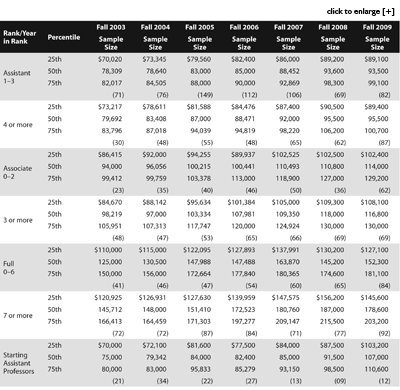Salary Survey of Biostatistics and Other Biomedical Statistics Departments
The data in tables 1 and 2 were revised January 19, 2010. There were errors in some of the original data resulting in inflated salaries. These have been corrected. Major changes to the tables occurred primarily for the third quartile and where there were small samples (such as for new assistant professors).
Below are results from the fall 2009 Salary Survey of Biostatistics and Other Biomedical Statistics Departments and Units conducted by the ASA. All salary figures are for a 12-month period. As in the past, previous salary survey data have been included for comparative purposes. The estimates are based on responses from 30 departments, plus a few individuals who responded to the survey. Questions regarding the tabulations should be addressed to Keith Crank, ASA research and graduate education manager, at keith@amstat.org. If you would like your biostatistical unit to participate in future surveys, also contact Crank.
Beginning with the 2009 survey, gender data were collected along with the salary information. Table 2 provides quartiles for the groups in Table 1, separated by gender. (Note: There were insufficient data to separate starting assistant professors by gender. Also, the counts in Table 2 are smaller than the corresponding counts in Table 1, because some respondents did not provide gender information.)
In 2009, we continued to collect data on nonfaculty academic statisticians and biostatisticians. Table 3 provides information about the salaries for full-time, nonfaculty, academic biostatisticians. (There were not enough responses for nonfaculty, academic statisticians to provide summary statistics.) Quartiles are provided for categories that have nine or more respondents. The 90th percentile is provided for any category that has 19 or more respondents. All percentiles are rounded to the nearest $100. (The information for three people with master’s degrees did not include years since highest degree. They are included in the row marked “All.”)
Table 1—2009–2010 Salaries of Biostatistics Faculty with Previous Years for Comparison
Table 2—2009–2010 Salaries of Biostatistics Faculty, by Gender
Table 3—2009 Salaries of Nonfaculty Academic Biostatisticians














 (2 votes, average: 4.50 out of 5)
(2 votes, average: 4.50 out of 5)
Social comments and analytics for this post…
This post was mentioned on Twitter by StatFr: RT @AmstatNews: Salary Survey of Biostatistics and Other Biomedical Statistics Departments http://tinyurl.com/ya8gjd3…
Something smells fishy.
Even after the correction, the median salary for starting assistant professors jumped by 17% last year. The largest recorded jump between any other two adjacent years was 7.6%. By itself, that looks extremely suspicious. Now, consider that the current recession hit at the end of 2008. The effects of the recession were the greatest that they had been, and perhaps the greatest that they will be, in mid-2009. This is reflected in the fact that many of the categories experienced a drop in salary in 2009.
Listen, I would love for the starting assistant professor salaries to be accurate. It would probably spread to other categories and ultimately result in an increase for everybody. However, no one is going to buy this – an unprecedented (no, more than that) increase in starting salaries in the middle of one of the worst economic downturns in recent history. So, can someone tell me what is really going on?
Response to FishFly: There are three things that contribute to the large change in starting salary for new Assistant Professors. First, the sample size is small, making this estimate highly variable. Second, the departments that hire new assistant professors (and respond to this survey) change each year, making the estimate even more variable. (Starting salaries in high cost of living areas explain some, but not all, of the increase.) Third, the demand for biostatisticians continues to increase, even in the midst of this recession.
While preparing the tables, I also noticed the large jump in starting salary. For that reason I confirmed the numbers for many of the higher values that were submitted in the survey.
Welcome!
Amstat News is the monthly membership magazine of the American Statistical Association, bringing you news and notices of the ASA, its chapters, its sections, and its members. Other departments in the magazine include announcements and news of upcoming meetings, continuing education courses, and statistics awards.
ASA HOME
Departments
Archives
ADVERTISERS
PROFESSIONAL OPPORTUNITIES
FDA
US Census Bureau
Software
STATA
QUOTABLE
“ My ASA friendships and partnerships are some of my most treasured, especially because the ASA has enabled me to work across many institutional boundaries and
with colleagues from many types of organizations.”
— Mark Daniel Ward
Editorial Staff
Managing Editor
Megan Murphy
Graphic Designers / Production Coordinators
Olivia Brown
Meg Ruyle
Communications Strategist
Val Nirala
Advertising Manager
Christina Bonner
Contributing Staff Members
Kim Gilliam
Contact us
Amstat News
American Statistical Association
732 North Washington Street
Alexandria, VA 22314-1904
(703) 684-1221
www.amstat.org
Address Changes
Amstat News Advertising